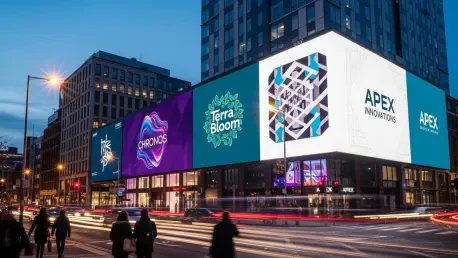The Evolution of Out-of-Home Advertising in Urban Spaces
The out-of-home (OOH) advertising industry has undergone a dramatic transformation over recent decades, moving from static billboards and posters to dynamic digital formats that capture attention in real-time. Once limited to painted signs and printed displays, OOH now leverages cutting-edge technology to deliver vibrant, adaptable content that resonates with modern audiences. This shift has been driven by advancements in LED screens and digital connectivity, allowing advertisers to update messages instantly and engage viewers with visually striking campaigns in bustling urban settings.
Urban environments, particularly high-traffic areas like transit hubs and commercial districts, have become prime real estate for digital OOH advertising due to their ability to reach diverse, on-the-move audiences. Places like train stations and bus terminals offer unparalleled exposure, as thousands of commuters pass through daily, creating opportunities for brands to make lasting impressions. Digital OOH in these spaces can adapt to time-specific messaging or even weather conditions, enhancing relevance and engagement compared to traditional static formats.
Key players such as Summit Outdoor Media and Ayala Malls are at the forefront of this evolution, integrating technology to redefine advertising strategies in the Philippines. Their efforts highlight a broader trend of using data and innovation to tailor campaigns for maximum impact. In a market like the Philippines, where urban centers are densely populated and culturally diverse, OOH advertising serves as a vital tool for brands to connect with varied demographics, bridging the gap between global trends and local consumer behaviors.
One Ayala’s Digital OOH Network: A Game-Changing Initiative
Innovative Features and Strategic Placement
At the heart of Makati’s Central Business District, the One Ayala OOH Digital Display Network stands as a pioneering project with 70 synchronized LED screens positioned across concourses, entrances, and key transit points. This extensive setup transforms the property into a cohesive advertising platform, ensuring that brands can deliver consistent, high-impact messages to a captive audience. The network’s design prioritizes visibility, making it nearly impossible for commuters and visitors to miss the dynamic content displayed.
A standout feature of this initiative is the concept of “station domination,” where a single brand can execute a full-site takeover, turning the entire hub into an immersive branded environment. This approach goes beyond traditional advertising by creating a seamless experience that surrounds individuals as they navigate through the space. Such strategies are particularly effective in a transit-oriented destination like One Ayala, which connects directly to MRT stations and bus terminals, serving as a critical junction for thousands daily.
The strategic placement within Makati, a hub of commerce and connectivity, amplifies the network’s potential to influence both local and transient populations. By integrating screens into lifestyle zones alongside transit areas, the setup ensures that messages reach not just commuters in a rush but also leisurely visitors exploring retail and dining options. This dual focus enhances the versatility of campaigns, catering to varied mindsets within the same location.
Impact and Early Success with Leading Brands
Since its launch, the One Ayala network has demonstrated measurable impact, with prominent brands like Visa, Globe, and Grab adopting the platform for synchronized campaigns. These early activations have showcased the power of unified messaging across multiple screens, creating a sense of omnipresence that strengthens brand recall among viewers. The ability to deliver visually cohesive narratives has proven effective in capturing attention in a fast-paced urban setting.
Beyond immediate visibility, the platform supports a range of advertising goals, from short-term promotional bursts to sustained branding efforts. Advertisers can leverage quick, eye-catching content for limited-time offers while also building long-term recognition through consistent thematic displays. This flexibility caters to diverse marketing needs, making the network a valuable asset for companies aiming to balance urgency with enduring presence.
The success of these initial campaigns underscores the network’s potential to set a new benchmark for digital OOH in the Philippines. Feedback from early adopters indicates strong engagement metrics, validating the investment in such an expansive digital ecosystem. As more brands recognize the value of immersive urban advertising, this initiative is poised to influence industry standards and inspire similar deployments in other high-traffic locales.
Challenges in Scaling Digital OOH Networks
Implementing and managing large-scale digital OOH networks like the one at One Ayala comes with significant hurdles, particularly in technological integration and ongoing maintenance. Ensuring that dozens of screens operate in sync requires robust software and hardware solutions, often accompanied by high upfront costs. Additionally, regular upkeep to prevent downtime or display malfunctions demands substantial resources and technical expertise.
Another challenge lies in audience targeting and measuring engagement within dynamic urban environments. Unlike online platforms where user data can be tracked with precision, OOH advertising in transit hubs must contend with transient, varied demographics whose interactions are harder to quantify. Developing methods to gauge campaign effectiveness in such settings remains a complex task, often requiring innovative approaches to data collection and analysis.
To address these obstacles, partnerships between media companies, technology providers, and property owners are essential for sharing expertise and costs. Leveraging data analytics to understand foot traffic patterns can also refine targeting strategies, while continuous advancements in display technology promise to reduce energy and maintenance demands. Overcoming these barriers will be crucial for scaling similar networks across other urban centers without compromising quality or impact.
Regulatory and Operational Considerations in Digital OOH
Navigating the regulatory landscape for digital advertising in the Philippines presents its own set of challenges, as compliance with local laws governing permits and public space usage is non-negotiable. Authorities often impose strict guidelines on content displayed in communal areas, ensuring that advertisements align with cultural and ethical standards. For a transit hub like One Ayala, adhering to these rules is critical to maintaining public trust and avoiding legal repercussions.
Content management in such a visible, community-centric space requires careful curation to respect the diverse sensibilities of commuters and visitors. Beyond legal requirements, there’s an implicit responsibility to ensure that messaging enhances rather than disrupts the user experience in shared environments. Striking this balance demands collaboration between advertisers and property managers to prioritize relevance and appropriateness in every campaign.
Operationally, the energy consumption of digital screens poses a concern, as large networks can contribute to significant electricity usage. Adopting sustainable practices, such as energy-efficient displays and optimized scheduling to reduce power draw during off-peak hours, becomes imperative. Addressing these operational aspects not only mitigates environmental impact but also aligns with growing expectations for corporate responsibility in advertising deployments.
The Future of Digital OOH with One Ayala as a Blueprint
The One Ayala network offers a compelling model for other urban hubs and properties under Ayala Malls, demonstrating how digital OOH can transform public spaces into vibrant advertising canvases. Its success suggests a scalable framework that could be replicated in similar transit-oriented or retail environments, potentially reshaping how brands interact with consumers across the country. This blueprint prioritizes integration into daily life, ensuring that advertising feels less intrusive and more complementary to urban experiences.
Emerging trends in digital OOH point toward deeper incorporation of interactive technologies and data-driven personalization to enhance user engagement. Imagine screens that respond to real-time inputs or campaigns tailored to specific audience segments based on movement patterns—these innovations are on the horizon. Such advancements could elevate the medium further, making it a more active participant in consumer journeys rather than a passive backdrop.
Market disruptors, including evolving consumer behaviors and global advertising innovations, will continue to shape the trajectory of OOH in local contexts. As attention spans shrink and digital integration becomes second nature, adaptability will be key to staying relevant. The One Ayala initiative, with its focus on scalability and forward-thinking design, positions itself as a leader in navigating these shifts, potentially influencing how retail and lifestyle spaces evolve over the coming years from 2025 onward.
A New Era for Urban Brand Engagement
Looking back, the launch of the One Ayala OOH Digital Display Network marked a turning point for digital advertising in the Philippines, showcasing how technology could redefine brand engagement in urban landscapes. The collaboration between Summit Outdoor Media and Ayala Malls crafted a platform that not only amplified visibility for advertisers but also enriched the daily experiences of commuters and visitors. This synergy established a precedent for transforming transit hubs into spaces of connection and inspiration.
Moving forward, stakeholders should focus on expanding this model to other high-traffic locations, tailoring implementations to unique regional dynamics while maintaining the core principles of immersion and innovation. Investing in analytics to better understand audience impact will further refine strategies, ensuring campaigns remain effective as urban demographics evolve. Additionally, prioritizing sustainability in future deployments can address operational challenges, setting an example for responsible growth in the industry.
Lastly, exploring partnerships with tech innovators to integrate emerging tools like augmented reality could push the boundaries of what digital OOH can achieve. By continuing to experiment with experiential solutions, the industry can build on this foundation, creating advertising ecosystems that resonate deeply with modern consumers. This proactive approach promises to sustain momentum, driving the next wave of urban brand interactions.









